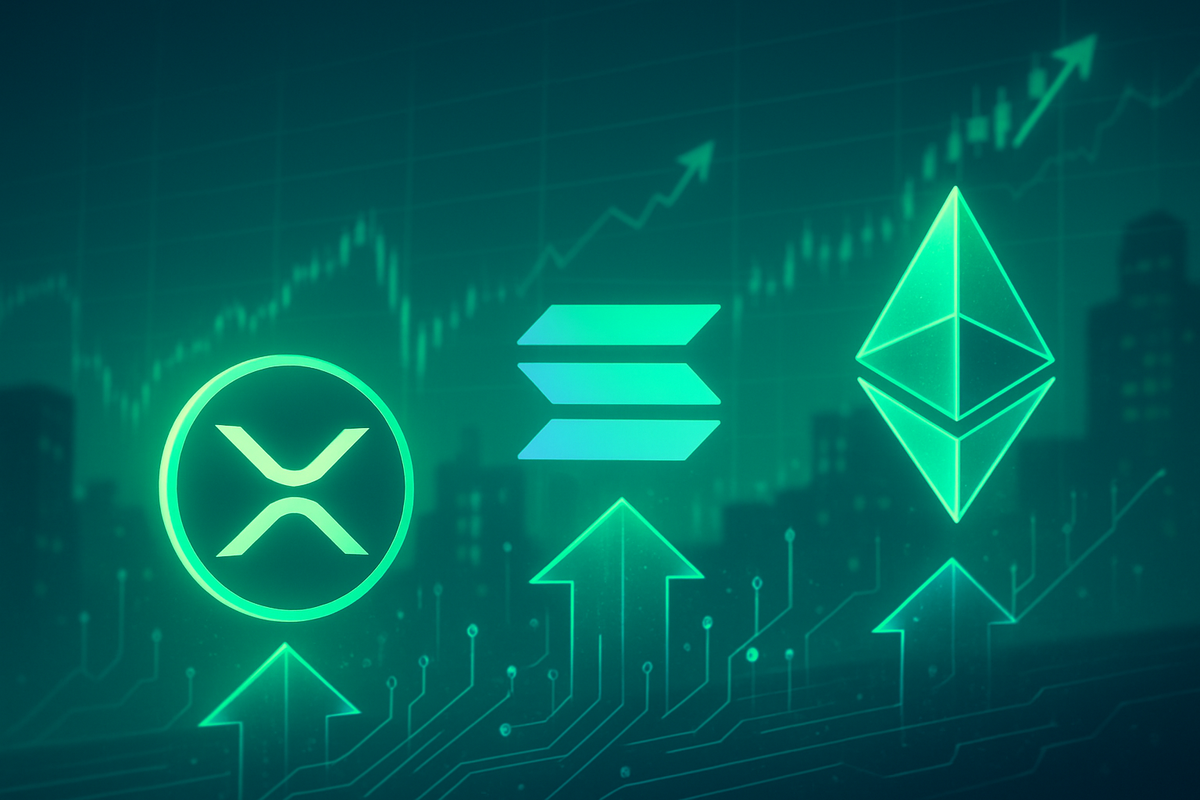
The cryptocurrency market is currently experiencing a robust uptrend, with key digital assets XRP, Solana (SOL), and Ethereum (ETH) demonstrating significant bullish momentum as October 2025 unfolds. This resurgence is largely attributed to a confluence of factors, including newfound regulatory clarity in the United States and a palpable surge in institutional adoption, signaling a maturation of the digital asset landscape. Investors are witnessing a pivotal moment where traditional finance is increasingly intertwining with the decentralized world, propelling these major cryptocurrencies to new performance benchmarks and reshaping market expectations.
This positive sentiment has translated into impressive gains across the board. XRP has achieved a historic quarterly close, Solana continues its rapid expansion in decentralized finance, and Ethereum has broken key psychological barriers, showcasing its enduring dominance as a foundational blockchain. The collective performance of these assets indicates a broader market shift, moving past previous uncertainties and embracing a future where cryptocurrencies play a more integrated role in global financial systems. The immediate implications point towards sustained growth and increased mainstream acceptance, setting the stage for an exciting period in the digital economy.
A Deep Dive into the Crypto Triumvirate: XRP, Solana, and Ethereum's Q3-Q4 2025 Surge
The third quarter of 2025 laid a strong foundation for the current bullish run, with early October continuing the momentum. XRP (XRP) concluded Q3 with its highest-ever quarterly close, hovering around $2.90, marking an impressive 28% gain for the quarter. This performance has been largely underpinned by a monumental shift in its regulatory standing. In August 2025, the U.S. Securities and Exchange Commission (SEC) reached a settlement with Ripple Labs (RPL), definitively reclassifying XRP as a utility token rather than a security. This landmark decision, further solidified by the SEC reportedly withdrawing its appeal, has removed a significant overhang that had plagued XRP for years, unleashing its growth potential. Adding to the fervor, the market is now eagerly anticipating SEC decisions on multiple spot XRP Exchange-Traded Fund (ETF) applications from major asset managers like Grayscale (GRYC), 21Shares (21S), WisdomTree (WT), Bitwise, and Franklin Templeton (FT), expected between October 18 and 25, 2025. Prediction markets are indicating a near-certainty of approval, which could unlock billions in institutional capital. Ripple's strategic moves, including the acquisition of prime brokerage firm Hidden Road for $1.25 billion, further underscore its ambition to integrate deeply into institutional finance.
Solana (SOL) has also been a standout performer, demonstrating robust bullish momentum with prices trading around $230-$235 in early October. The network saw its decentralized exchange (DEX) volume reach an astounding $326 billion in Q3 2025, a 21% increase quarter-over-quarter, consistently outperforming other major blockchains. The Total Value Locked (TVL) in Solana's DeFi ecosystem surged to $8.6 billion, reflecting its growing utility and adoption. A major catalyst for Solana's recent rally is the imminent launch of 24/7 Solana futures and options trading by the CME Group (CME) on October 13, 2025, which is set to significantly broaden global derivatives access for traditional investors. Furthermore, an SEC ruling on spot Solana ETFs is also anticipated this month, following the success of REX-Osprey's Solana Staking ETF ($SSK), which has already surpassed $500 million in assets under management (AUM). Technologically, Solana is preparing for key upgrades like Alpenglow Consensus and SIMD-0286, promising enhanced transaction finality and increased block capacity, further solidifying its position as a high-throughput blockchain.
Ethereum (ETH), the second-largest cryptocurrency by market capitalization, has equally commanded attention, breaking past the psychological $4,000 barrier and consistently trading between $4,470 and $4,514 in early October. Q3 2025 was a breakout quarter for Ethereum, with its price surging by 66.8%, significantly outperforming Bitcoin's (BTC) 6.3% gain and marking its strongest Q3 growth since 2016. This impressive performance is fueled by strong institutional interest and capital inflows into Ethereum-focused ETFs, with spot ETH ETFs recording over $80 million in net inflows over three consecutive days in early October, and one US Spot Ethereum ETF attracting a staggering $1 billion in inflows within a single week. The network's Layer-1 recently broke a four-year record for daily transactions, propelled by the expansion of Decentralized Finance (DeFi), a revival of the NFT market, and new Layer 2 developments. Upcoming upgrades like Fusaka are expected to significantly reduce Layer-2 transaction costs, enhancing scalability and user experience, while regulatory moves in the US pushing stablecoins and DeFi further into the mainstream directly benefit Ethereum as the foundational layer.
Market Movers: Who Stands to Gain or Lose from the Crypto Surge?
The current bullish wave in XRP, Solana, and Ethereum markets presents significant opportunities and challenges for a wide array of public companies and stakeholders. Ripple Labs (RPL), the company behind XRP, stands as a primary beneficiary. The regulatory clarity surrounding XRP and the potential approval of spot XRP ETFs could dramatically increase the demand for XRP, bolstering Ripple's balance sheet and validating its long-term strategy of integrating XRP into cross-border payments. Companies involved in the XRP ecosystem, such as payment providers and financial institutions partnering with Ripple, are also poised for growth as the utility of XRP expands.
Major cryptocurrency exchanges like Coinbase (COIN), Binance (BNB) (though not publicly traded in the US, its ecosystem tokens like BNB are affected), and Kraken are direct winners. Increased trading volumes across XRP, SOL, and ETH translate directly into higher transaction fees and revenue for these platforms. The approval of spot ETFs for these cryptocurrencies would also likely likely drive more institutional clients to their custody and trading services. Furthermore, companies that have invested heavily in the infrastructure supporting these blockchains, such as hardware manufacturers for mining (though less relevant for PoS like ETH and SOL, more for general crypto infrastructure) and software development firms building on these ecosystems, will see increased demand for their services.
Conversely, traditional financial institutions that have been slow to embrace digital assets might find themselves losing market share or being forced to accelerate their crypto strategies. While some, like CME Group (CME), are proactively launching new crypto derivatives products, others that remain on the sidelines risk being outpaced. Companies with significant exposure to legacy financial systems that could be disrupted by more efficient, blockchain-based alternatives may face headwinds. Moreover, projects or smaller altcoins that fail to innovate or gain significant adoption could see capital diverted to these leading cryptocurrencies, struggling to maintain relevance in a more competitive and mature market. Investment funds that have underweight positions in these performing assets might also underperform compared to their crypto-focused counterparts.
Broader Implications: Reshaping the Financial Landscape
The sustained rally in XRP, Solana, and Ethereum is not merely a market event; it represents a significant chapter in the broader narrative of digital asset integration into the global financial system. This event fits squarely into the overarching trend of institutional adoption and regulatory maturation that has been gaining traction throughout 2025. The regulatory clarity achieved for XRP, in particular, sets a powerful precedent for other digital assets, potentially paving the way for a more defined legal framework across the industry. This clarity reduces uncertainty, a major barrier for institutional investors, and encourages further mainstream participation.
The ripple effects of this performance are substantial. Competitors within the blockchain space are compelled to innovate and differentiate, as the leading networks continue to enhance their scalability, efficiency, and ecosystem development. For example, other Layer-1 blockchains must now contend with Solana's impressive DEX volumes and Ethereum's dominant DeFi presence, pushing them to accelerate their own technological roadmaps. Partners within these ecosystems, such as decentralized application (dApp) developers, stablecoin issuers, and NFT platforms, will benefit from increased network activity and liquidity, fostering further innovation and growth.
Regulatory bodies globally are also closely observing these developments. The SEC's actions regarding XRP and the anticipated decisions on spot ETFs for XRP, SOL, and ETH will undoubtedly influence how other jurisdictions approach digital asset regulation. This could lead to a domino effect, where clearer guidelines emerge in other major financial markets, further legitimizing the asset class. Historically, the approval of Bitcoin (BTC) ETFs in early 2024 served as a watershed moment, opening the floodgates for institutional capital. The potential approval of ETFs for XRP, SOL, and ETH marks a continuation of this trend, signaling a diversification of institutional interest beyond just Bitcoin and towards other high-utility and high-potential cryptocurrencies. This gradual, yet consistent, integration into regulated financial products is a testament to the enduring appeal and growing acceptance of digital assets as a legitimate asset class.
The Road Ahead: Navigating Future Opportunities and Challenges
Looking ahead, the short-term outlook for XRP, Solana, and Ethereum appears bullish, primarily driven by the imminent decisions on spot ETFs. Should these approvals materialize as widely anticipated, a significant influx of institutional capital could further propel prices upward, potentially setting new all-time highs for these assets. In the long term, continued technological advancements, such as Ethereum's Fusaka upgrade and Solana's Alpenglow and Firedancer upgrades, are expected to enhance network capabilities, reduce costs, and improve user experience, solidifying their competitive advantages. For XRP, its integration into traditional financial services via Ripple's partnerships and acquisitions will be a key determinant of its long-term utility and value.
Potential strategic pivots for companies in the crypto space will likely revolve around leveraging these leading blockchains. Financial institutions may increasingly explore offering custody, trading, and even staking services for ETH and SOL, while payment companies could integrate XRP for more efficient cross-border transactions. Market opportunities will emerge for developers building on these robust ecosystems, creating new DeFi protocols, NFT marketplaces, and enterprise solutions. The growing institutional interest also paves the way for more sophisticated financial products, such as structured products and lending platforms collateralized by these cryptocurrencies.
However, challenges remain. Regulatory scrutiny, while providing clarity, can also introduce new compliance burdens. The competitive landscape among Layer-1 blockchains is intense, and while ETH and SOL are leading, continuous innovation is essential to maintain their edge. Macroeconomic factors, such as inflation and interest rate changes, could still introduce volatility into the broader crypto market. Potential scenarios include a sustained bull run if ETF approvals meet expectations and institutional adoption accelerates, or a period of consolidation if market participants decide to take profits after significant gains. A less likely, but still possible, scenario involves regulatory setbacks or unexpected technical vulnerabilities, which could dampen enthusiasm. Nevertheless, the current trajectory suggests a path towards greater integration and mainstream acceptance.
A New Era for Digital Assets: Key Takeaways and Future Watchpoints
The performance of XRP, Solana, and Ethereum in Q3 and early Q4 2025 marks a definitive turning point for the cryptocurrency market. The primary takeaway is the undeniable shift towards regulatory clarity and widespread institutional adoption, transforming digital assets from a niche investment into a recognized and increasingly integrated component of the global financial system. The SEC's stance on XRP, coupled with the anticipated approvals of spot ETFs for these leading cryptocurrencies, represents a powerful validation of their utility and investment potential. This period underscores the market's growing maturity, where fundamental developments and regulatory frameworks are now driving significant price action, rather than speculative fervor alone.
Moving forward, the market is poised for continued evolution. The increasing participation of traditional finance giants like CME Group (CME), Grayscale (GRYC), and Franklin Templeton (FT) signifies a lasting impact, bridging the gap between conventional and decentralized finance. Investors should closely watch the outcomes of the impending ETF decisions for XRP, SOL, and ETH, as these will likely dictate short-term market movements and institutional capital flows. Beyond price action, monitoring the ongoing technological upgrades and ecosystem developments within Ethereum and Solana will be crucial indicators of their long-term growth trajectories. For XRP, its continued success will hinge on its adoption in real-world payment solutions and its ability to maintain its regulatory advantage.
In the coming months, the focus will remain on how these assets integrate further into existing financial infrastructures, the evolution of regulatory landscapes globally, and the emergence of new use cases. The current bullish momentum suggests a robust future for these digital assets, making them critical components for any forward-looking investor.
This content is intended for informational purposes only and is not financial advice.





